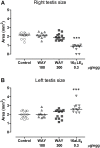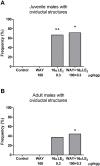Effects of selective and combined activation of estrogen receptor α and β on reproductive organ development and sexual behaviour in Japanese quail (Coturnix japonica)
- PMID: 28671963
- PMCID: PMC5495399
- DOI: 10.1371/journal.pone.0180548
Effects of selective and combined activation of estrogen receptor α and β on reproductive organ development and sexual behaviour in Japanese quail (Coturnix japonica)
Abstract
Excess estrogen exposure of avian embryos perturbs reproductive organ development in both sexes and demasculinizes the reproductive behaviors of adult males. We have previously shown that these characteristic effects on the reproductive organs also can be induced by exposure of Japanese quail (Coturnix japonica) embryos to selective agonists of estrogen receptor alpha (ERα). In contrast, the male copulatory behavior is only weakly affected by developmental exposure to an ERα agonist. To further elucidate the respective roles of ERα and ERβ in estrogen-induced disruption of sexual differentiation, we exposed Japanese quail embryos in ovo to the selective ERα agonist 16α-lactone-estradiol (16αLE2), the selective ERβ agonist WAY-200070, or both substances in combination. The ERα agonist feminized the testes in male embryos and reduced cloacal gland size in adult males. Furthermore, anomalous retention and malformations of the Müllerian ducts/oviducts were seen in embryos and juveniles of both sexes. The ERβ agonist did not induce any of these effects and did not influence the action of the ERα agonist. Male copulatory behavior was not affected by embryonic exposure to either the ERα- or the ERβ-selective agonist but was slightly suppressed by treatment with the two compounds combined. Our results suggest that the reproductive organs become sexually differentiated consequent to activation of ERα by endogenous estrogens; excessive activation of ERα, but not ERβ, during embryonic development may disrupt this process. Our results also suggest that the demasculinizing effect of estrogens on male copulatory behavior is only partly mediated by ERα and ERβ, and may rather involve other estrogen-responsive pathways.
Conflict of interest statement
Figures










Similar articles
-
Effects on differentiation of reproductive organs and sexual behaviour in Japanese quail by excessive embryonic ERalpha activation.Reprod Fertil Dev. 2010;22(2):416-25. doi: 10.1071/RD08293. Reprod Fertil Dev. 2010. PMID: 20047727
-
Selective activation of estrogen receptor alpha in Japanese quail embryos affects reproductive organ differentiation but not the male sexual behavior or the parvocellular vasotocin system.Gen Comp Endocrinol. 2008 Nov-Dec;159(2-3):150-7. doi: 10.1016/j.ygcen.2008.08.012. Epub 2008 Sep 6. Gen Comp Endocrinol. 2008. PMID: 18805421
-
Effects of estrogens on sex differentiation in Japanese quail and chicken.Gen Comp Endocrinol. 2009 Sep 1;163(1-2):97-103. doi: 10.1016/j.ygcen.2009.01.006. Epub 2009 Jan 23. Gen Comp Endocrinol. 2009. PMID: 19523394 Review.
-
Selective estrogen receptor alpha activation disrupts sex organ differentiation and induces expression of vitellogenin II and very low-density apolipoprotein II in Japanese quail embryos.Reproduction. 2008 Aug;136(2):175-86. doi: 10.1530/REP-08-0100. Epub 2008 May 15. Reproduction. 2008. PMID: 18483074
-
Impact of endocrine disrupting chemicals on reproduction in Japanese quail.Domest Anim Endocrinol. 2005 Aug;29(2):420-9. doi: 10.1016/j.domaniend.2005.02.036. Epub 2005 Apr 7. Domest Anim Endocrinol. 2005. PMID: 15998507 Review.
Cited by
-
Estrogen receptor and temperature independently influence sex determination in the red-eared slider turtle.Front Endocrinol (Lausanne). 2025 Jul 21;16:1632672. doi: 10.3389/fendo.2025.1632672. eCollection 2025. Front Endocrinol (Lausanne). 2025. PMID: 40761814 Free PMC article.
-
Key role of estrogen receptor β in the organization of brain and behavior of the Japanese quail.Horm Behav. 2020 Sep;125:104827. doi: 10.1016/j.yhbeh.2020.104827. Epub 2020 Aug 14. Horm Behav. 2020. PMID: 32735801 Free PMC article.
-
Dietary supplementation of nano-selenium improves reproductive performance, sexual behavior and deposition of selenium in the testis and ovary of Japanese quail.J Adv Vet Anim Res. 2020 Oct 1;7(4):597-607. doi: 10.5455/javar.2020.g457. eCollection 2020 Dec. J Adv Vet Anim Res. 2020. PMID: 33409302 Free PMC article.
-
Proliferative and Apoptotic Pathways in the Testis of Quail Coturnix coturnix during the Seasonal Reproductive Cycle.Animals (Basel). 2021 Jun 9;11(6):1729. doi: 10.3390/ani11061729. Animals (Basel). 2021. PMID: 34207904 Free PMC article.
-
The Aromatase-Estrogen System in the Testes of Non-Mammalian Vertebrates.Animals (Basel). 2021 Jun 12;11(6):1763. doi: 10.3390/ani11061763. Animals (Basel). 2021. PMID: 34204693 Free PMC article. Review.
References
-
- Scheib D, Guichard A, Mignot T-M, Reyss-Brion M. Early sex differences in hormonal potentialities of gonads from quail embryos with a sex-linked pigmentation marker: An in vitro radioimmunoassay study. Gen Comp Endocrinol. 1985;60(2):266–72. - PubMed
-
- Scheib D. Effects and role of estrogens in avian gonadal differentiation. Differentiation. 1983;23 (Suppl.):S87–92. - PubMed
-
- Elbrecht A, Smith RG. Aromatase enzyme activity and sex determination in chickens. Science. 1992;255(5043):467–70. - PubMed
-
- Vaillant S, Guémené D, Dorizzi M, Pieau C, Richard-Mercier N, Brillard J-P. Degree of sex reversal as related to plasma steroid levels in genetic female chickens (Gallus domesticus) treated with fadrozole. Mol Reprod Dev. 2003;65(4):420–8. doi: 10.1002/mrd.10318 - DOI - PubMed
-
- Balthazart J, De Clerck A, Foidart A. Behavioral demasculinization of female quail is induced by estrogens: Studies with the new aromatase inhibitor, R76713. Horm Behav. 1992;26(2):179–203. - PubMed
MeSH terms
Substances
LinkOut - more resources
Full Text Sources
Other Literature Sources

